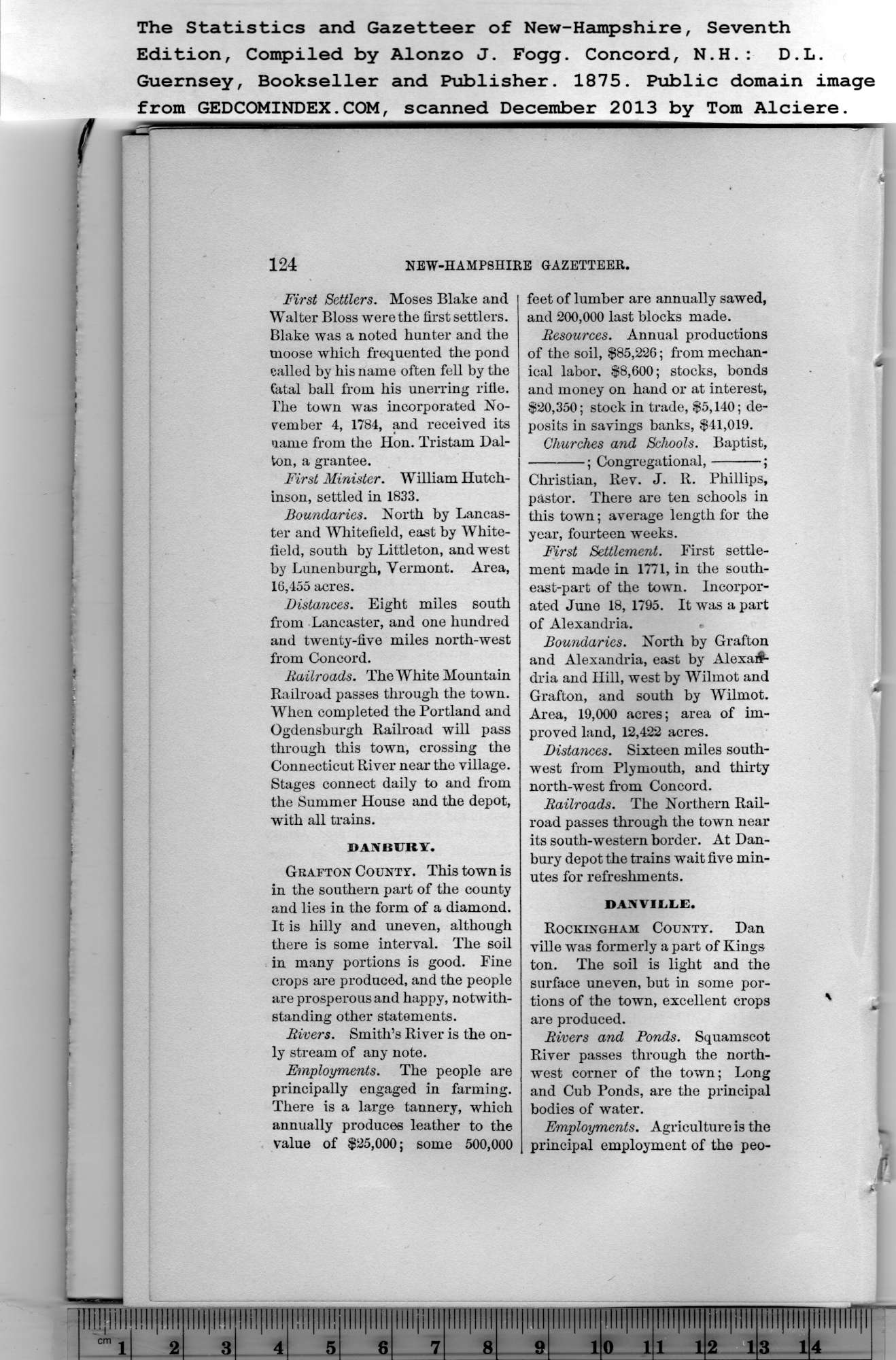|
124
The Statistics and Gazetteer of New-Hampshire, Seventh
Edition, Compiled by Alonzo J. Fogg. Concord, N.H.: D.L.
First Settlers. Moses Blake and
Walter Bloss were the first settlers.
Blake was a noted hunter and the
moose which frequented the pond
called by his name often fell by the
fatal ball from his unerring rifle.
The town was incorporated No-
vember 4, 1784, and received its
name from the Hon. Tristam Dal-
ton, a grantee.
First Minister. William Hutch-
inson, settled in 1833.
Boundaries. North by Lancas-
ter and Whitefield, east by White-
field, south by Littleton, and west
by Lunenburgh, Vermont. Area,
16,455 acres.
Distances. Eight miles south
from Lancaster, and one hundred
and twenty-five miles north-west
from Concord.
Railroads. The White Mountain
Railroad passes through the town.
When completed the Portland and
Ogdensburgh Railroad will pass
through this town, crossing the
Connecticut River near the village.
Stages connect daily to and from
the Summer House and the depot,
with all trains.
HAMSUHV.
Grafton County. This town is
in the southern part of the county
and lies in the form of a diamond.
It is hilly and uneven, although
there is some interval. The soil
in many portions is good. Fine
crops are produced, and the people
are prosperous and happy, notwith-
standing other statements.
Rivers. Smith’s River is the on-
ly stream of any note.
Employments. The people are
principally engaged in farming.
There is a large tannery, which
annually produces leather to the
value of $25,000; some 500,000
feet of lumber are annually sawed,
and 200,000 last blocks made. |
Resources. Annual productions
of the soil, $85,226; from mechan-
ical labor. $8,600; stocks, bonds
and money on hand or at interest,
$20,350; stock in trade, $5,140; de-
posits in savings banks, $41,019.
Churches and Schools. Baptist,
--; Congregational,-;
Christian, Rev. J. R. Phillips,
pastor. There are ten schools in
this town; average length for the
year, fourteen weeks.
First Settlement. First settle-
ment made in 1771, in the south-
east-part of the town. Incorpor-
ated June 18, 1795. It was a part
of Alexandria.
Boundaries. North by Grafton
and Alexandria, east by Alexan-
dria and Hill, west by Wilmot and
Grafton, and south by Wilmot.
Area, 19,000 acres; area of im-
proved land, 12,422 acres.
Distances. Sixteen miles south-
west from Plymouth, and thirty
north-west from Concord.
Railroads. The Northern Rail-
road passes through the town near
its south-western border. At Dan-
bury depot the trains wait five min-
utes for refreshments.
DANVILLE.
Rockingham County. Dan
ville was formerly a part of Kings
ton. The soil is light and the
surface uneven, but in some por-
tions of the town, excellent crops
are produced.
Rivers and Ponds. Squamscot
River passes through the north-
west corner of the town; Long
and Cub Ponds, are the principal
bodies of water.
Employments. Agriculture is the
principal employment of the peo- |
